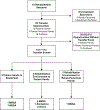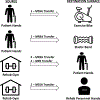Contamination of Common Area and Rehabilitation Gym Environment with Multidrug-Resistant Organisms
- PMID: 31851386
- PMCID: PMC9190293
- DOI: 10.1111/jgs.16284
Contamination of Common Area and Rehabilitation Gym Environment with Multidrug-Resistant Organisms
Abstract
Objectives: To quantify the multidrug-resistant organism (MDRO) burden of high-touch common area and rehabilitation gym surfaces, and to assess microorganism transfer potential during rehabilitation sessions.
Design: Prospective study of environmental contamination.
Setting: Nursing home (NH).
Participants: Six Michigan NHs.
Measurements: Monthly samples from common area surfaces (eg, living room), rehabilitation equipment, and rehabilitation personnel hands were screened for methicillin-resistant Staphylococcus aureus (MRSA), vancomycin-resistant enterococci (VRE), and resistant gram-negative bacilli (R-GNB). To assess microorganism transfer potential, we conducted an in-depth assessment of microorganism transfer during 10 rehabilitation sessions. Microorganism transfer was defined as the identification of a microorganism on a destination surface that was uncontaminated before the rehabilitation session. Patient frequency of common area usage was also assessed qualitatively.
Results: We obtained 1338 common area specimens from 180 monthly facility visits, of which 13.4% (179/1338) were MDRO positive: MRSA, 3.8%; VRE, 5.8%; and R-GNB, 5.1%. A total of 64% (116/180) of sampling visits had at least one MDRO-positive common area specimen. Within rehabilitation gyms, we obtained 521 equipment and 190 personnel hand specimens during 60 monthly visits. Of the equipment specimens collected, 7.7% (40/521) were MDRO positive: MRSA, 2.5%; VRE, 4.0%; and R-GNB, 1.9%. Of the 190 rehabilitation personnel hand specimens collected, 3.7% (7/190) were MDRO positive. Overall, 55% (33/60) of rehabilitation gym visits had at least one MDRO-positive specimen. Microorganism transfer assessment during 10 rehabilitation sessions revealed 35 opportunities for transfer during which microorganism transfer occurred in 17.1% (6/35) of opportunities.
Conclusion: NH common areas and rehabilitation gyms are MDRO reservoirs that may contribute to the transmission of healthcare-associated pathogens. Because NHs accommodate the increasing short-stay patient population, developing effective interventions that reduce MDRO transmission in the common area and rehabilitation gym environment should be considered an infection prevention priority. J Am Geriatr Soc 68:478-485, 2020.
Keywords: environmental contamination; multidrug-resistant organisms; nursing home; rehabilitation; transmission.
© 2019 The American Geriatrics Society.
Conflict of interest statement
Conflict of Interest
The authors report no conflicts of interest.
Figures



Comment in
-
Do Clean Common Areas Save Lives?J Am Geriatr Soc. 2020 Mar;68(3):460-462. doi: 10.1111/jgs.16283. Epub 2019 Dec 18. J Am Geriatr Soc. 2020. PMID: 31851378 No abstract available.
References
-
- Burke RE, Juarez-Colunga E, Levy C, Prochazka AV, Coleman EA, Ginde AA. Rise of Post–Acute Care Facilities as a Discharge Destination of US Hospitalizations. JAMA Internal Medicine. 2015;175: 295–296. - PubMed

